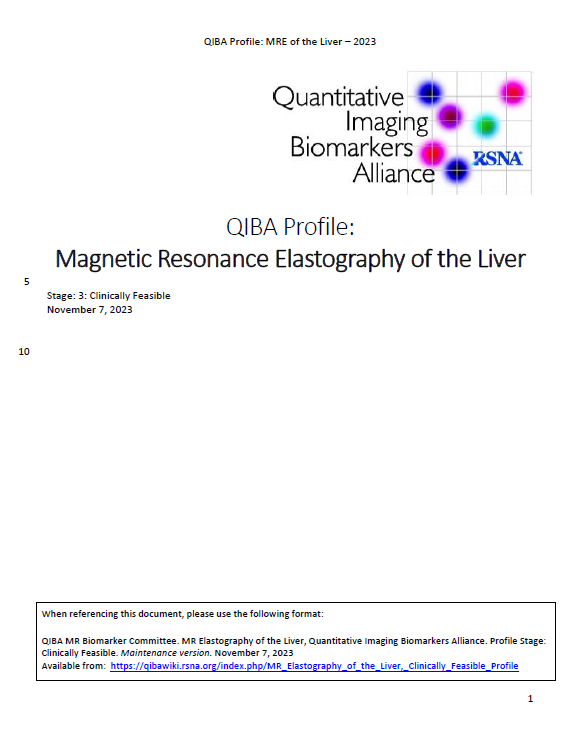Difference between revisions of "MR Elastography of the Liver, Clinically Feasible Profile"
| (10 intermediate revisions by the same user not shown) | |||
| Line 1: | Line 1: | ||
| − | + | [[Image:MRE Profile Page1.PNG|left|thumb|193x193px|link=https://qibawiki.rsna.org/images/4/47/MRE-QIBAProfile-2023-11-07-CLINICALLY-FEASIBLE-maintenance.pdf'''|alt=|'''^ Full text''']] | |
| − | + | <br /> | |
| + | <br /> | ||
| + | === <u>Publication Details</u> === | ||
| + | Author: QIBA MRE Biomarker Committee<br/>Version: Stage 3: Clinically Feasible, Maintenance draft<br/>DOI: <insert><br />Publication date: 2023 Nov. 7<br /> | ||
| − | === | + | <br /> |
| − | + | <br /> | |
| + | === <u>Executive Summary</u> === | ||
| + | The goal of a QIBA Profile is to help achieve a useful level of performance for a given biomarker. | ||
| + | |||
| + | The '''Claim''' (Section 2) describes the biomarker performance. | ||
| + | |||
| + | The '''Activities''' (Section 3) contribute to generating the biomarker. Requirements are placed on the Actors that participate in those activities as necessary to achieve the Claim. | ||
| + | |||
| + | '''Assessment Procedures''' (Section 4) for evaluating specific requirements are defined as needed. | ||
| + | |||
| + | This QIBA Profile ('''Magnetic Resonance Elastography of the Liver''') addresses the application of Magnetic | ||
| + | Resonance Elastography (MRE) for the quantification of liver stiffness, which is often used as a '''biomarker of liver fibrosis'''. It places requirements on '''Acquisition Devices, Technologists, Radiologists, | ||
| + | Reconstruction Software and Image Analysis Tools''' involved in '''Subject Handling, Image Data Acquisition, Image Data Reconstruction, Image QA and Image Analysis'''. | ||
| + | |||
| + | The requirements are focused on achieving sufficient accuracy and avoiding unnecessary variability of | ||
| + | the measurement of hepatic stiffness. | ||
| + | |||
| + | The clinical performance target is '''to achieve a 95% confidence interval for a true change in stiffness | ||
| + | has occurred when there is a measured change in hepatic stiffness of 19% or larger'''. | ||
| + | |||
| + | This document is intended to help clinicians basing decisions on this biomarker, imaging staff generating | ||
| + | this biomarker, vendor staff developing related products, purchasers of such products and investigators | ||
| + | designing trials with imaging endpoints. | ||
| + | |||
| + | Note that this document only states requirements to achieve the claim, not “requirements on standard | ||
| + | of care.” Conformance to this Profile is secondary to properly caring for the patient. | ||
| + | |||
| + | QIBA Profiles addressing other imaging biomarkers using CT, MRI, PET and Ultrasound can be found at | ||
| + | https://qibawiki.rsna.org/index.php/Profiles. | ||
Latest revision as of 16:06, 3 May 2024
Publication Details
Author: QIBA MRE Biomarker Committee
Version: Stage 3: Clinically Feasible, Maintenance draft
DOI: <insert>
Publication date: 2023 Nov. 7
Executive Summary
The goal of a QIBA Profile is to help achieve a useful level of performance for a given biomarker.
The Claim (Section 2) describes the biomarker performance.
The Activities (Section 3) contribute to generating the biomarker. Requirements are placed on the Actors that participate in those activities as necessary to achieve the Claim.
Assessment Procedures (Section 4) for evaluating specific requirements are defined as needed.
This QIBA Profile (Magnetic Resonance Elastography of the Liver) addresses the application of Magnetic Resonance Elastography (MRE) for the quantification of liver stiffness, which is often used as a biomarker of liver fibrosis. It places requirements on Acquisition Devices, Technologists, Radiologists, Reconstruction Software and Image Analysis Tools involved in Subject Handling, Image Data Acquisition, Image Data Reconstruction, Image QA and Image Analysis.
The requirements are focused on achieving sufficient accuracy and avoiding unnecessary variability of the measurement of hepatic stiffness.
The clinical performance target is to achieve a 95% confidence interval for a true change in stiffness has occurred when there is a measured change in hepatic stiffness of 19% or larger.
This document is intended to help clinicians basing decisions on this biomarker, imaging staff generating this biomarker, vendor staff developing related products, purchasers of such products and investigators designing trials with imaging endpoints.
Note that this document only states requirements to achieve the claim, not “requirements on standard of care.” Conformance to this Profile is secondary to properly caring for the patient.
QIBA Profiles addressing other imaging biomarkers using CT, MRI, PET and Ultrasound can be found at https://qibawiki.rsna.org/index.php/Profiles.
